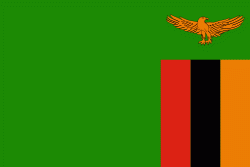Ndola (Ndola Rural District)
Ndola is the third largest city in Zambia and third in terms of size and population, with a population of 475,194 (2010 census provisional), after the capital, Lusaka, and Kitwe, and the second largest in terms of infrastructure development after Lusaka. It is the industrial and commercial center of the Copperbelt, Zambia's copper-mining region, and capital of Copperbelt Province. It lies just 10 km from the border with DR Congo. It is also home to Zambia's first modern stadium, the Levy Mwanawasa Stadium.
What is now Ndola was first inhabited by the Lamba people led by Senior Chief Chiwala, the Lamba people migrated from the Luba-Lunda kingdom around 1600 and the town of Ndola was under Chief Mushili for some time but now it is under Chief Chiwala who came to the Lambaland during the slave trade from Malawi. The name Ndola is derived from the river, which originates in the Kaloko Hills and drains in the Kafubu River.
The town of Ndola was founded in 1904, by John Edward "Chiripula" Stephenson just six months after Livingstone, making it the second oldest colonial-era town of Zambia. It was started as a boma and trading post, which laid its foundations as an administrative and trading centre today.
The Rhodesia Railways main line reached the town in 1907, providing passenger services as far south as Bulawayo, with connections to Cape Town. The line was extended into DR Congo and from there eventually linked to the Benguela Railway to the Atlantic port of Lobito (which took some of Zambia's copper exports for many years with recent interruptions by closures; the rail line is now back in service). The Ndola railhead was responsible for the town becoming the country's centre of distribution. Before the road network was built up in the 1930s, a track from Ndola to Kapalala on the Luapula River, and boat transport from there to the Chambeshi River was the principal trade route for the Northern Province, which consequently formed part of Ndola's hinterland.
In 1961, an airplane carrying key United Nations figures, including the organisation's second Secretary General Dag Hammarskjöld, crashed on the outskirts of Ndola.
What is now Ndola was first inhabited by the Lamba people led by Senior Chief Chiwala, the Lamba people migrated from the Luba-Lunda kingdom around 1600 and the town of Ndola was under Chief Mushili for some time but now it is under Chief Chiwala who came to the Lambaland during the slave trade from Malawi. The name Ndola is derived from the river, which originates in the Kaloko Hills and drains in the Kafubu River.
The town of Ndola was founded in 1904, by John Edward "Chiripula" Stephenson just six months after Livingstone, making it the second oldest colonial-era town of Zambia. It was started as a boma and trading post, which laid its foundations as an administrative and trading centre today.
The Rhodesia Railways main line reached the town in 1907, providing passenger services as far south as Bulawayo, with connections to Cape Town. The line was extended into DR Congo and from there eventually linked to the Benguela Railway to the Atlantic port of Lobito (which took some of Zambia's copper exports for many years with recent interruptions by closures; the rail line is now back in service). The Ndola railhead was responsible for the town becoming the country's centre of distribution. Before the road network was built up in the 1930s, a track from Ndola to Kapalala on the Luapula River, and boat transport from there to the Chambeshi River was the principal trade route for the Northern Province, which consequently formed part of Ndola's hinterland.
In 1961, an airplane carrying key United Nations figures, including the organisation's second Secretary General Dag Hammarskjöld, crashed on the outskirts of Ndola.
Map - Ndola (Ndola Rural District)
Map
Country - Zambia
 |
 |
| Flag of Zambia | |
The region was affected by the Bantu expansion of the 13th century. Following the arrival of European explorers in the 18th century, the British colonised the region into the British protectorates of Barotseland-North-Western Rhodesia and North-Eastern Rhodesia comprising 73 tribes, towards the end of the 19th century. These were merged in 1911 to form Northern Rhodesia. For most of the colonial period, Zambia was governed by an administration appointed from London with the advice of the British South Africa Company. On 24 October 1964, Zambia became independent of the United Kingdom and prime minister Kenneth Kaunda became the inaugural president. From 1972 to 1991 Zambia was a one-party state with the United National Independence Party as the sole legal political party under the motto "One Zambia, One Nation" coined by Kaunda. Kaunda was succeeded by Frederick Chiluba of the social-democratic Movement for Multi-Party Democracy in 1991, beginning a period of government decentralisation.
Currency / Language
| ISO | Currency | Symbol | Significant figures |
|---|---|---|---|
| ZMW | Zambian kwacha | ZK | 2 |
| ISO | Language |
|---|---|
| NY | Chichewa language |
| EN | English language |















